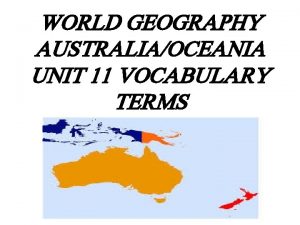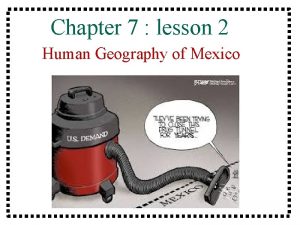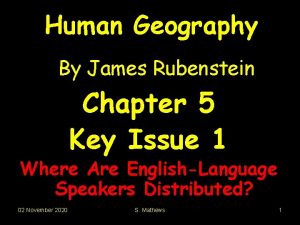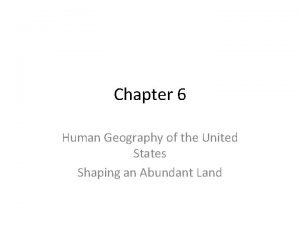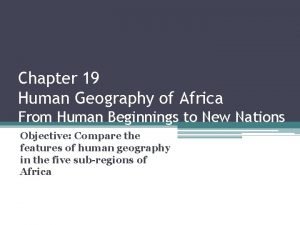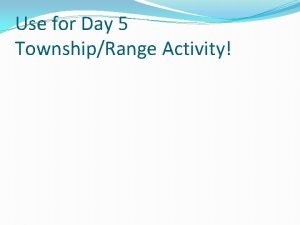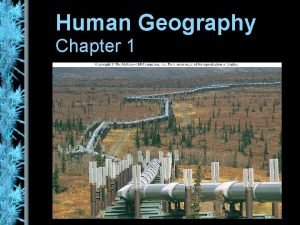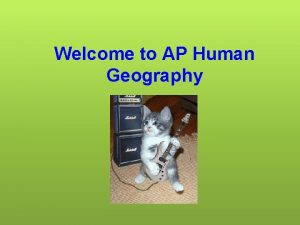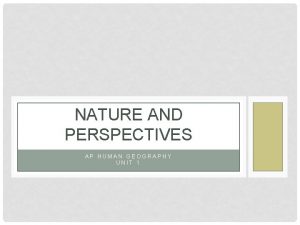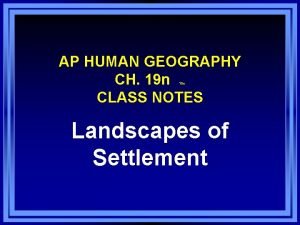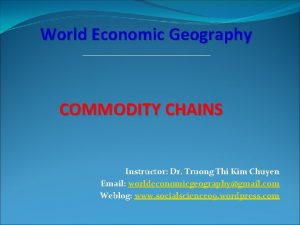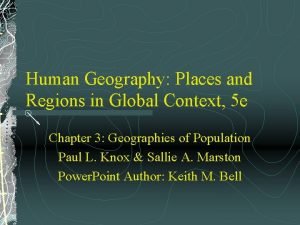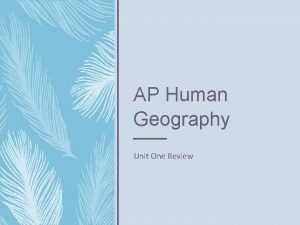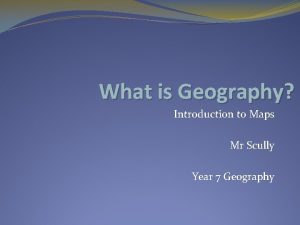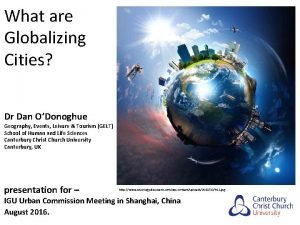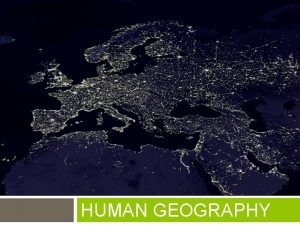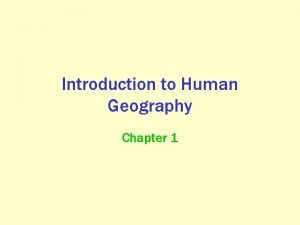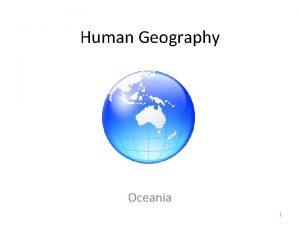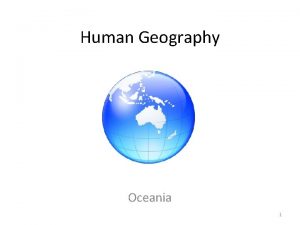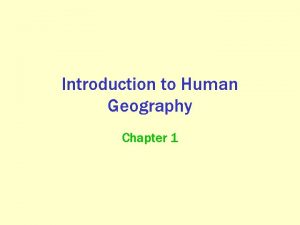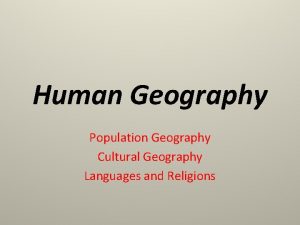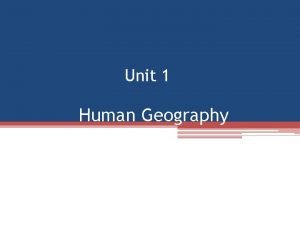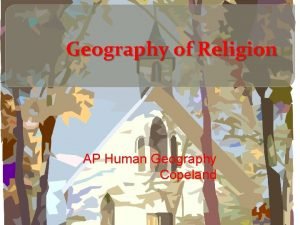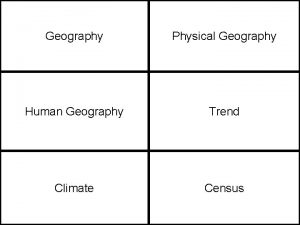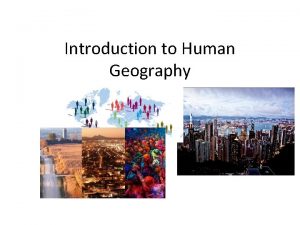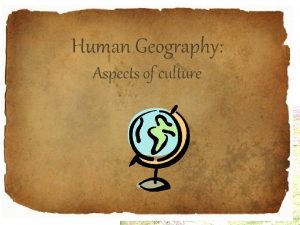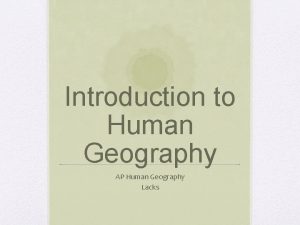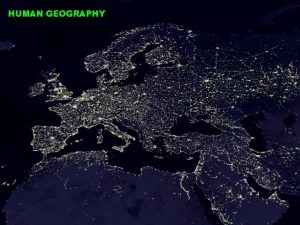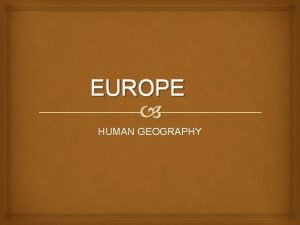CHAPTER 1 GEOGRAPHY AND HUMAN GEOGRAPHY WHAT IS
































- Slides: 32

CHAPTER 1 GEOGRAPHY AND HUMAN GEOGRAPHY

WHAT IS THE TASK OF THE HUMAN GEOGRAPHER? • Spatial Analysis. What is it? • Analyze features of the Earth’s surface. Where/Why there/Why Care? • Look for distribution and pattern • 2 MAJOR DIVISIONS OF GEOGRAPHY STUDY? • Physical Geography (Natural) • Human Geography (Cultural)

5 THEMES OF GEOGRAPHY • 1. LOCATION

2. HUMAN / ENVIRONMENT INTERACTION

3. REGION

1. Which of the following is true concerning regions? • a) they are figments of the imagination • b) they are conceptual units • c) they all have well defined boundaries • d) they are strict functional units • e) they are usually defined by a standard mathematical formula

4. PLACE

5. MOVEMENT

WHAT’S MISSING • When National Geographic society created the 5 themes they did not include…. . Landscape

MAIN TOOL OF THE GEOGRAPHER? • MAP! • Map Making • History: Original study of map making… Cartography • Today: we use remote sensing geographic information systems… use aircraft, photography, satellites, environmental changes. • What is the challenge? • (Hint: Curves)

MAIN TOOL OF THE GEOGRAPHER? • MAP • Maps demonstrate vital Geo. Rule: • No two places are exactly alike

THINGS TO CONSIDER WITH MAPS • Maps are created for different purposes • Maps have a focus • Maps tell a story • Maps are timely / ever changing





“UNIQUE” SPIN ON MAPS MENTAL (Cognitive) MAP • Who knows what the State of IL looks like? ? ? DRAW IT!!!!!


2. Which of the following is false regarding cognitive (mental) maps? a. b. c. d. e. They vary between people of different social and educational backgrounds They enable people to navigate through space No two cognitive (mental) maps look the same They accurately reflect mapped hazards They guide spatial behavior 3. A cognitive (mental) map tells us a. b. c. d. e. which projection to use what someone believes and thinks is important about a place the absolute location of features in the landscape everything that someone knows about the place they live the precise location of the most important landmarks

LOCATION IN MAPS: 2 IDEAS • Location is essential to understanding maps… WHY? • How do we break down LOCATION?

Absolute Location (Site) Vs. Relative Location (Situation)

REGIONS • Why is “space” organized into REGIONS? ? ? • Organization • To group phenomena • Distinguish between regions

REGIONS BASED ON…? ? ? • Physical > Mtn. Range, Land type • Cultural > language, religion • Imagination > In our minds • All regions have AREA & BOUNDARIES


3 REGION CLASSIFICATIONS 1. FORMAL / UNIFORM Based on similarity or uniform characteristics throughout region • TIBET • Plateau • Buddhism


REGION CLASSIFICATIONS CONT’D 2. FUNCTIONAL / NODAL Product of interactions or movement of some kind • Social / Econ. Relationship ties it together • City & Suburbs • Commuting • Living v. Working


REGION CLASSIFICATIONS CONT’D • 3. PERCEPTUAL / VERNACULAR Exists in the minds of people • “DEEP South” • “Dixie” • “Gold Coast” • “Bible Belt”


4. Perceptual regions reflect a. b. c. d. personal or popular impressions of territory and spatial divisions are perceived through the application of defined spatial criteria have boundaries of clearly visible, self-evident physical or cultural change have meaning only in physical geography, which deals with perceivable objects 5. A perceptual region’s boundaries are a. b. c. d. e. determined by a set of uniform physical or cultural characteristics drawn around the functions that occur between a particular place and the surrounding area fuzzy because they allow for individual interpretation designated by the inclusion of a particular cultural characteristic

6. All of the following are formal regions except: a. b. c. d. a city and its surrounding region a region where nearly everyone spoke French a region where farming practices were the same a region of similar climate 7. Perceptual culture regions are: a. b. c. d. sharply defined boundaries different in exact definition from person to person defined by using at least three criteria found only on islands
 Frq format ap human geography
Frq format ap human geography 5 themes of geography ap human geography
5 themes of geography ap human geography Proruption ap human geography
Proruption ap human geography Gni definition ap human geography
Gni definition ap human geography Human needs and human development
Human needs and human development Chapter 8 human needs and human development
Chapter 8 human needs and human development Ap human geography chapter 11 vocab
Ap human geography chapter 11 vocab Chapter 16 section 2 transcaucasia
Chapter 16 section 2 transcaucasia Chapter 22 human geography of southwest asia
Chapter 22 human geography of southwest asia Chapter 11 ap human geography
Chapter 11 ap human geography Lesson 2 human geography of mexico
Lesson 2 human geography of mexico Dispersal hypothesis ap human geography
Dispersal hypothesis ap human geography Chapter 13 human geography of europe
Chapter 13 human geography of europe Chapter 5 key issue 1 ap human geography
Chapter 5 key issue 1 ap human geography Chapter 6 human geography of the united states
Chapter 6 human geography of the united states Chapter 25 section 3 nepal and bhutan
Chapter 25 section 3 nepal and bhutan Chapter 19 section 1 east africa
Chapter 19 section 1 east africa Township and range ap human geography
Township and range ap human geography Township and range ap human geography
Township and range ap human geography Relative location
Relative location Township and range definition ap human geography
Township and range definition ap human geography Township and range system ap human geography
Township and range system ap human geography Metes and bounds aphg
Metes and bounds aphg Human and economic geography
Human and economic geography Human geography places and regions in global context
Human geography places and regions in global context Rimland theroy
Rimland theroy Metes and bounds ap human geography
Metes and bounds ap human geography Ap human geography songs
Ap human geography songs Human nouns
Human nouns Diversity and human needs and development
Diversity and human needs and development Whats round robin
Whats round robin Topographic map definition ap human geography
Topographic map definition ap human geography Alpha beta gamma cities ap human geography
Alpha beta gamma cities ap human geography






